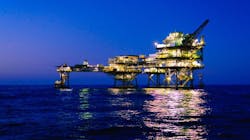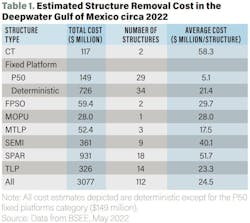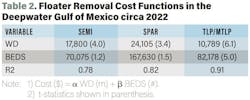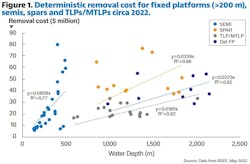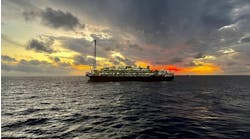Work decomposition methods can help estimate deepwater platform removal costs
Editor's note: This feature article (fourth in a four-part series) first appeared in the March-April 2024 issue of Offshore magazine. Click here to view the full issue.
By Mark J. Kaiser, Louisiana State University
In the final part of this series on the deepwater US Gulf of Mexico, we consider BSEE decommissioning cost estimates for floating structures.
Circa 2022, spars and TLPs were the largest floater classes with 18 and 14 units, respectively, followed by 9 semis, 3 MTLPs, 2 FPSOs, and one MOPU.
Spar decommissioning costs are estimated at $55 million per structure, while ship-shape floaters are expected to cost around $30 million and tension leg platforms and their smaller (mini) versions between $18-25 million apiece to decommission (Table 1).
Work decomposition
Since 2016 when BSEE first started to collect operator decommissioning cost data, only three fixed platforms and two floaters have been decommissioned in >200 m water depth. Because of the sparsity of available data, statistical methods are not feasible, and other methods must be applied.
Work decomposition methods are the only credible means available for estimating removal cost for floating structures.
Work decomposition methods are formal hypothetical cost estimates which are performed by experienced offshore engineers breaking down operations into several tasks that need to be performed, and then estimating the time and cost of each task.
Work decomposition methods may or may not be calibrated or compared to actual jobs and generally lack a high degree of confidence in the results, but for specialized/unique operations (i.e., floater decommissioning) and/or where sparse data sets dominate, they are the only acceptable method available.
FPSO/MOPU
There are three ship-shaped floaters operating in the US Gulf of Mexico c. 2022 – Turritella FPSO (Stones), BW Pioneer FPSO (Cascade/Chinook), and the Helix MOPU (GC237) – which are expected to cost around $30 million each to decommission.
For FPSOs and MOPUs (and semisubmersibles), the deck is an integrated part of the structure, and after the mooring lines and risers are removed, the vessel can simply sail away to dockside at the end of its life.
The pile system of the mooring/tendons may be left in place or may be required to be cut 15 ft below the mudline and removed.
Semis
The nine semis in the US Gulf of Mexico are expected to cost on average about $40 million each to decommission, ranging from $28 million (Who Dat) to about $54 million for the much larger Jack-St Malo, Mirage/Titan and Thunderhorse units.
The Jack-St Malo, Thunder Horse and Mirage/Titan semis reside in 2,119 m, 1,965 m and 1,325 m water depths, respectively, while Who Dat resides in 990 m.
Semis are structurally like their drilling rig namesakes but are more robust and heavier and are also capable of being towed to port without removing their topsides before transit. Bed counts for the sample range from 48 (Who Dat) to 298 (Thunderhorse).
The decommissioning cost function for this class of floater based only on water depth is given by:
Semi cost = 22,300 WD
where WD is described in meters. The model fit for this one-variable model is better than the two-variable models involving bed count (0.86 vs. 0.78), but one might still prefer a less robust model in application, especially if alternative complexity proxies are applied.
In 2019, the Independence Hub semi was removed and towed to port where it sat for two years before being resold in 2021 to LLOG Exploration. LLOG bought Independence Hub from offshore pipeline operator Genesis Energy for $40 million and plans to refurbish it for its new Salamanca floating production unit serving the Leon and Castile fields in Keathley Canyon.
TLP/MTLPs
For TLPs and spars, decks are removed in one piece using a floatover technique, derrick barge or crane vessel. Cargo barges transport the deck and modules to a shipyard for storage and reuse or scrap.
After the deck sections have been removed, and the mooring/tendons have been cut and removed, the hull is removed in-situ either in a single lift or in multiple lifts, depending on the lifting capacity of the crane vessel.
Other removal options may also exist such as float away, and the most economical method will depend on the equipment availability, technical feasibility, dayrates, and regulatory approval.
The 14 TLPs and 3 MTLPs in the US Gulf of Mexico c.2022 have an expected total removal cost of $379 million, or $22.3 million per floater.
MTLPs are slightly less expensive to decommission at $17.5 million/MTLP and TLPs slightly more expensive at $23.3 million/TLP.
As their name suggests, MTLPs (mini TLPs) are smaller versions of TLPs, weigh less, host fewer wells with less production capacity, and operate in smaller water depth.
Bed counts for both classes range from 22 (Prince) to 225 (Auger). Olympus and Bigfoot are recent TLP installations.
The decommissioning cost function for the combined MTLP/TLP group is given by:
TLP/MTLP cost = 18,500 WD
where WD is described in meters. Model coefficients for the TLP/MTLP cost function with bed count are shown in Table 2.
In 2021, the MTLP Morpeth was the second MTLP decommissioned in the U.S. Gulf of Mexico; the first MTLP decommissioned was the hurricane-destroyed Typhoon which lost its mooring and was flipped over and beached in shallow water. Typhoon was towed to an offshore reef site while Morpeth was towed back to port.
Spars
There are 18 spars with an estimated total decommissioning cost of $931 million, or about $51 million per spar. Bed counts range from 40 (Nansen) to 162 (Mad Dog).
The spar decommissioning cost function is given by:
Spar cost = 33,900 WD
where WD is described in meters. Model coefficients for the SPAR cost function with bed count are shown in Table 2.
In 2014, Anadarko’s Red Hawk truss spar was decommissioned in the U.S. Gulf of Mexico and turned into a reef site.
Class comparison
The unit cost for TLP/MTLPs, semis, and spars per water depth installed increase from $18,500/m for TLP/MTLPs, to $22,300/m for semis, and $33,900/m for spars (Figure 1).
Unit costs are greater for fixed platforms and compliant towers, where deterministic estimates are $85,141/m and $113,000/m, respectively.
Disclaimer
Work decomposition methods are currently the only viable means to estimate floater decommissioning cost in the US Gulf of Mexico and the cost functions shown are only provided as a descriptive comparative measure.
Comparative cost functions do not purport to represent BSEE cost methodology, but rather, are simply a means to better understand the characteristics of the cost estimates based on their water depth characteristics.
About the author: Mark J. Kaiser is a Professor with the Center for Energy Studies, Louisiana State University, Baton Rouge, Louisiana.
